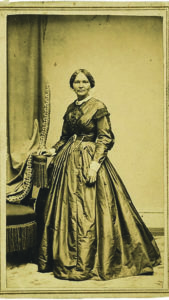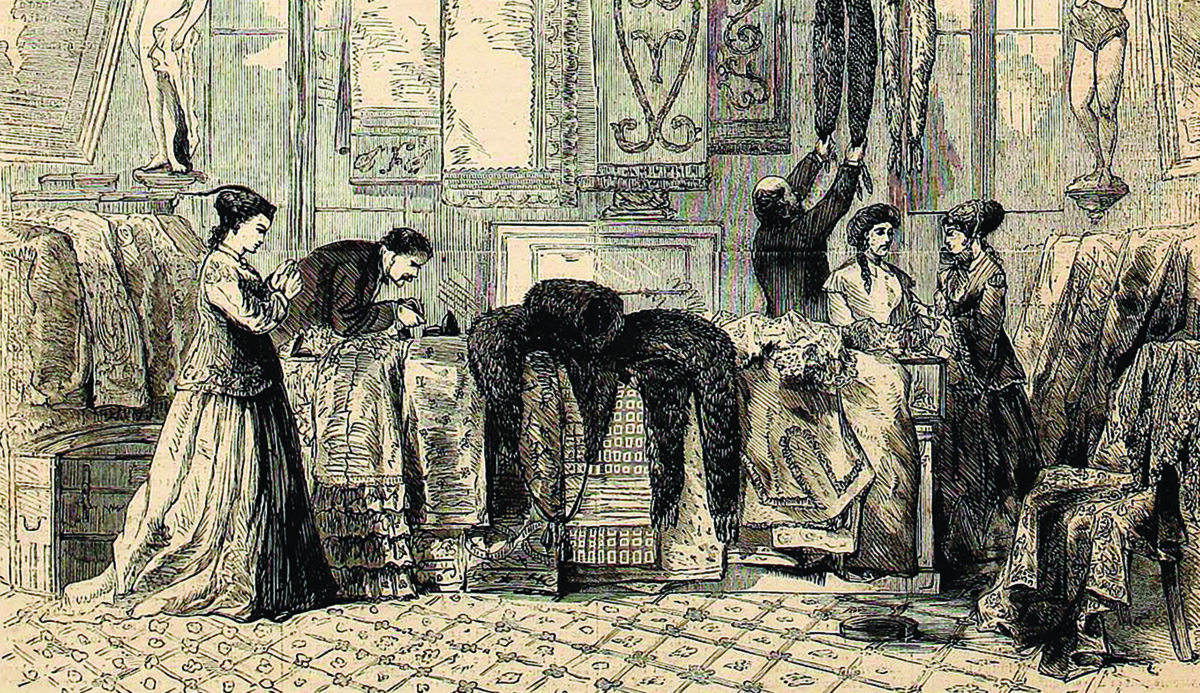“A smile half-sorrowful and wholly sweet makes you love her face as soon as you look on it,” Mary Clemmer Ames wrote from Washington, DC, in the New York Evening Post in 1862. “It is a face strong with intellect, and heart, with enough of beauty left to tell you that it was more beautiful still before wrong and grief shadowed it.” The journalist was describing seamstress Elizabeth Keckly years before Keckly endured her life’s most historic and shattering event.
Keckly’s painful early times were all too common in the antebellum South. She was born enslaved to Aggy Hobbs, a mixed-race Black, and Hobbs’s White owner, Armistead Burwell, in Dinwiddie County, Virginia. When the girl was 18, Alexander Kirkland, a White neighbor, repeatedly raped her, leading to a pregnancy. That son, passing as Caucasian, served—and died—in the Union Army. Keckly spent the years 1842 to 1855 in Petersburg, Virginia, and St. Louis, Missouri, both home to thriving free black communities. In 1855, Keckly, 37, purchased her freedom. She went on to be a successful dressmaker, at the apex of her career becoming modiste and confidante to Mary Todd Lincoln. The quietly determined Keckly’s life moved from extraordinary to unique thanks to her groundbreaking 1868 memoir. Behind the Scenes, Or Thirty Years a Slave and Four Years in the White House, circulated first as a White House tell-all, hugely embarrassing to the widow Lincoln and surviving son Robert—and unnerving to White elites, costing Keckly her social standing and financial security. The dressmaker’s remarkable life story remained unexplored until 2003, with publication of Jennifer Fleischner’s book Mrs. Lincoln and Mrs. Keckly, correcting historians who had long been misspelling her name as “Keckley.”
By the time Keckly brought out Behind the Scenes in 1868, publishers had been acquainting readers with life in bondage and freedom via accounts by figures such as Frederick Douglass and Harriet Jacobs. Memoirs about Abraham Lincoln were popping up. But the only other story of life inside the White House published prior to Keckly’s had been a brief recollection by Paul Jennings, who, enslaved by the Madison family, worked in the presidential mansion at age 10. In her book Keckly, writing at age 50, chronicles not only her life but four years in close companionship with the Lincolns, including frequent interactions with the president. In recounting her youth Keckly depicts a girl and young woman of disciplined defiance and resolve. Born into a prominent slaveholding family, she learned to read and write. She had to leave her extended family in Dinwiddie and move with her owner’s son, Robert, to Hillsboro, North Carolina, scene of a bitter ordeal for her. She fought back during a schoolmaster’s beatings, demanded by her mistress to “subdue her stubborn pride,” and endured Kirkland’s repeated rapes, the genesis of son George. Keckly portrays the abuse with little detail or sentiment. She then was taken by Armistead Burwell’s daughter, Ann, to Petersburg, then St. Louis, where she briefly wed fellow slave James Keckly, an alcoholic who had lied that he was free. She gives her proud exit from bondage more coverage: rather than flee North, she insisted on buying her freedom. White friends and dressmaking clients lent her the $1,200 (well over $30,000 today), which she repaid in full.

Keckly then brought her enterprise to Baltimore. When business slowed, she moved to DC, where she met prominent customers like Mary Custis Lee, wife of Colonel Robert E. Lee, and Varina Davis, wed to Secretary of War Jefferson Davis. In 1861 Mary Lincoln, new to the capital and White House life, became a client, making Keckly her confidante. Keckly saw Lincoln’s wife through the deaths of son Willie and husband Abraham, personally preparing Willie Lincoln’s body for burial. Keckly recalls moments ranging from standing with the president watching the family goats frolic in the White House yard to traveling with the family into Richmond after the rebel capital fell, where, for a moment, the former slave seated herself where Jefferson Davis and Alexander Stephens had sat to lead the Confederacy. She describes Mrs. Lincoln summoning her the night her husband was shot and how she “soothed the terrible tornado as best I could.” Keckly paints Abraham Lincoln as a gentle savior, and his wife as a politically astute but volatile woman prone to excesses of everything from grief, jealousy, and other emotions to outlays on clothing and White House furnishings. Mary Todd Lincoln appears to be everything Keckly is not—yet the two enjoyed a mutual ease likely born of familiarity with plantation life and the shared travails of their sons’ deaths.
After Lincoln’s murder, the women shared a problem: lack of money. When Mary Todd Lincoln sought Keckly’s help managing the sale of gowns from her days as a First Lady, people gawked but no one bought. What the widow had intended as a private event proved to be a humiliating public spectacle.
According to Keckly, she wrote and published her memoir to generate sympathy for Mary Todd Lincoln—and to make money. Exactly the opposite occurred. Mrs. Lincoln’s instability and indulgence were well known. Keckly’s intimate portrait enraged her former client, shattering their relationship. Robert Todd Lincoln throttled distribution of the memoir, which not only quoted from but reproduced nearly two dozen letters to Keckly from Mrs. Lincoln, as well as a letter to the widow from Frederick Douglass offering the Black community’s aid. Keckly maintained she never meant to publish the letters but had provided them to the publisher only as substantiation. There is no record of the manuscript’s preparation except for a neighbor’s recollection of well-known abolitionist journalist and publisher James Redpath visiting Keckly. The ruckus, including a racist parody titled “Behind the Seams,” quashed any hope Keckly had of setting the record straight and benefiting from her experience. Even so, the letters’ contents do document Keckly’s value to the otherwise friendless and oft-distraught Mary, who in the midst of the clothing sale scandal beseeched her to “write me every day.”
Keckly struggled the rest of her life. Son George’s Civil War service provided a small pension, but to obtain it she had to lie that she had married his father, the rapist Kirkland. For a time, she taught sewing in Xenia, Ohio, at the college George had attended: Wilberforce University, founded in 1856 for Blacks—often the mixed-race children of White slaveholders. By 1895, she was back in DC, where she had helped establish the National Home for Destitute Colored Women and Children, where she died in 1907. Her pastor, the Reverend Francis Grimké, who had his own complex ancestry as a mixed-race nephew of the activist Grimké sisters through their brother Henry, eulogized her. He recalled Keckly as the “personification of grace and dignity…She was not an educated woman, in the sense that she had passed through any educational institution, but she was a woman of marked intelligence and had made good use of the opportunities that she had of improving her mind. No one who ever saw her, or had any contact with her, even casually, would ever be likely to forget her.”
This Cameo column appeared in the April 2021 issue of American History.





